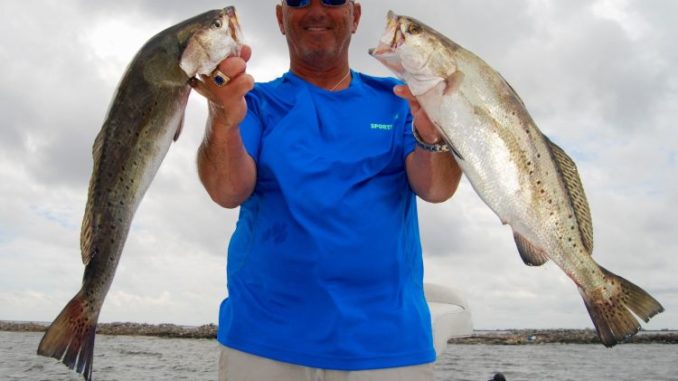
Beach action will be on early in the morning and later in the afternoon, Vidrine says
June is typically a banner month for speckled trout on Grand Isle, but don’t plan on enjoying the island life and sleeping in if you intend on catching specks this month.
“The beach will be on fire from Fourchon all the way to Timbalier Island. But you need to wake up at daybreak, or go out from 6 p.m. to dark,” said Tommy Vidrine, who specializes in catching hammer specks free-lining live bait at the Caminada Pass jetties. “When the water gets hot, especially on the beach, they’ll be real close to the first trough at daybreak. Then they’ll move out to the second trough at about 9 because the first one is too hot when the sun gets up and it’s 95 degrees.
“After about 9 or 10 o’clock, you won’t catch them on the beach. I don’t know if they go offshore and just wait, or if they’re full, but at daybreak on the beach, shrimp are popping and pogies are everywhere — it’s like a feeding frenzy. You throw a croaker in there, and it gets devoured.”
Live croakers — along with shrimp and pogies — are Vidrine’s go-to bait for specks this month. It’s a close call, but Vidrine gives the edge to live croakers right now.
“June is the perfect month for croakers,” Vidrine said. “They’re bigger, and you can buy them at Bridge Side.”
He refers to the plump croakers and big shrimp available there as “Bridge Side Dynamite,” and said fish in the 3- to 4-inch range are perfect when they’re in stock.
“Buggie (Vegas) does such a good job with those fish. Their filtering system for the water is outstanding,” Vidrine said. “”It’s like a swimming pool, with filter sand. The water is really clean. They’re not selling any beat up croakers.”
Vidrine suggested running the aerator and recirculator in your livewell to keep the croakers healthy as long as possible, and he stressed to make sure your hands are free of bug spray, soap, cologne, perfume and sunscreen when you reach in to grab one.
“That happens to a lot of people and they just don’t think about it,” he said. “If you look in the livewell and see those croakers barely moving, they’ve probably been poisoned.”
He favors a larger kahle hook with live croakers so the hook’s barb can make it to the trout’s mouth.
“I think the No. 3 kahle hook is the best hook for croakers, because when you set the hook, they have all that meat in their mouth,” he said. “If you get too small on the hook with a good-sized croaker, the hook won’t set.”
A key to consistent hookups when free-lining with live croakers is patience on the hook set, he said.
“Even if the trout is running sideways with it, you let him go until he’s sucked it in all the way and wants to swallow it,” he said. “Then when you set the hook, their mouth is closed all the way, the fish is all the way in and you’ll hook them.”
As always, Vidrine looks for clean water, and prefers an incoming tide when he’s fishing the front side of the island.
“That’s my favorite because you’re getting the Gulf water, and if it’s been calm, you’re getting green water coming in,” he said. “But if it’s muddy, you’re wasting your time. Because if the trout can’t see, they’re not going to eat and they’re not going to be there.
“They’re going to move to clear water — even if they have to go offshore — to be able to eat.”


